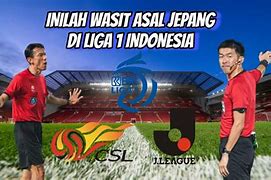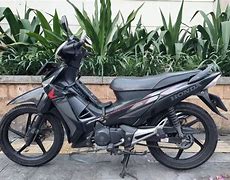Bảng xếp hạng - Liga 1, Indonesia 2024/2025, Indonesia
Top Indonesian association football league
Liga 1 (English: League 1), also known as BRI Liga 1 for sponsorship reasons with Bank Rakyat Indonesia, is the men's top professional football division of the Indonesian football league system. Administered by the PT Liga Indonesia Baru (lit. 'New Indonesian League, LLC'), Liga 1 is contested by 18 clubs and operates on a system of promotion and relegation with Liga 2.
Top-flight professional league in Indonesia started from the 2008–09 season onwards, initially under the name Indonesia Super League until 2015.[3] Before PSSI formed and organized the Indonesian Super League as the first professional football league in Indonesia, the previous top-level competition title in Indonesia was the Liga Indonesia Premier Division from 1994–95 to 2007–08.[4] Prior to the 2008 reforms, the national competitions used a tournament format.[5] Liga 1, which started in 2017, is the most recent rebranding of the league.[3]
Forty-two teams have competed in the top-tier league of Indonesian football since the start of the modern era in 2008 as the Indonesia Super League. Eight teams have been crowned champions, with Persipura Jayapura winning the title three times (2009, 2011, 2013), the most among the teams.[6]
In 1994, PSSI merged the existing Perserikatan and Galatama to form Liga Indonesia. This decision was taken to increase the quality of Indonesian football. In order to do so, PSSI sought to combine supporter's fanaticism from Perserikatan and Galatama's professionalism. The Premier Division was the first-tier in Liga Indonesia. The system stayed put until 2007.[7]
In 2008, PSSI formed the Indonesia Super League (ISL), the first fully professional league in Indonesia, as the new top-tier of Indonesian football. The Premier Division was then being relegated to the second-tier.[7]
The modern competition era started in 2008 with the 2008–09 Indonesia Super League. The first season began with 18 clubs. The first Indonesia Super League goal was scored by Ernest Jeremiah of Persipura in a 2–2 draw against Sriwijaya F.C.[8] The 18 inaugural members of the new Indonesia Super League were Persipura, Persiwa, Persib, Persik, Sriwijaya, Persela, Persija, PSM, Pelita Jaya, Arema, Persijap, Persiba, PKT Bontang, Persitara, PSMS, Deltras, Persita, and PSIS. Originally, Persiter and Persmin qualified to register but they failed the verification requirements to be inaugural members of the Indonesia Super League.[9]
As the football scene in Indonesia was heavily politicized with rival factions upending each other, conflict was the norm prior to 2017. The worst conflict occurred in 2011. After the inauguration of the new PSSI board in 2011, a member of PSSI's Executive Committee and chairman of its Competition Committee, Sihar Sitorus, appointed PT Liga Prima Indonesia Sportindo as the new league operator replacing PT Liga Indonesia because LI failed to provide an accountability report to the PSSI. Sitorus, one of many politicians in the PSSI, announced the Indonesia Premier League as the new top-level competition in Indonesia. Upon the emergence of Liga Primer Indonesia (LPI), PSSI did not recognize the validity of ISL. ISL regulars PSM, Persema, and Persibo, which had boycotted the ISL operators due to referee and management decisions, gladly defected to join LPI along with splinters of existing ISL teams.[10] However, the 2011 LPI season was stopped mid-season, due to continued schism within PSSI; a new league, Indonesian Premier League (Liga Prima Indonesia, IPL) replaced it in late 2011 for the 2011–12 season.[11][12]
Before the schism of PSSI, Sitorus triggered more controversy when he said the new competition would be divided into two regions and there would be an addition of six clubs in the top division, which angered many association members.[13] Thus, 14 teams that were supposed to be Indonesia Premier League contestants chose to support the Indonesia Super League that continued to roll under the support of the pro-IPL faction, despite being labeled as an illegal competition.[14] The official PSSI, supported by FIFA and AFC, did not recognize the ISL for two seasons.[15] In the meantime, the Indonesian Premier League became the top-tier league from 2011 to 2013 with only 11 teams.[11][16]
In a PSSI extraordinary meeting on 17 March 2013, association members slammed Sitorus and decided that the Indonesia Super League would once again emerge as the top-level competition, following the disbandment of the Indonesian Premier League.[17] Sitorus and five other PSSI board members were suspended from the sport for their roles in the split (locally referred to as dualisme, lit. 'dualism') that disrupted Indonesian football.[18]
The new PSSI board also decided that the best seven teams of the 2013 Indonesian Premier League, following verification, would join the unified league.[19] Semen Padang, Persiba Bantul, Persijap, and PSM passed verification, while Perseman, Persepar, and Pro Duta did not, meaning the 2014 season was contested with 22 teams.[20][21]
Offenbar hast du diese Funktion zu schnell genutzt. Du wurdest vorübergehend von der Nutzung dieser Funktion blockiert.
Notes, comments, and feedback
Despite our very best efforts to allow anybody to adjust the website to their needs. There may still be pages or sections that are not fully accessible, are in the process of becoming accessible, or are lacking an adequate technological solution to make them accessible. Still, we are continually improving our accessibility, adding, updating and improving its options and features, and developing and adopting new technologies. All this is meant to reach the optimal level of accessibility, following technological advancements. For any assistance, please reach out to
Additional UI, design, and readability adjustments
Accessibility Statement
We firmly believe that the internet should be available and accessible to anyone, and are committed to providing a website that is accessible to the widest possible audience, regardless of circumstance and ability.
To fulfill this, we aim to adhere as strictly as possible to the World Wide Web Consortium’s (W3C) Web Content Accessibility Guidelines 2.1 (WCAG 2.1) at the AA level. These guidelines explain how to make web content accessible to people with a wide array of disabilities. Complying with those guidelines helps us ensure that the website is accessible to all people: blind people, people with motor impairments, visual impairment, cognitive disabilities, and more.
This website utilizes various technologies that are meant to make it as accessible as possible at all times. We utilize an accessibility interface that allows persons with specific disabilities to adjust the website’s UI (user interface) and design it to their personal needs.
Additionally, the website utilizes an AI-based application that runs in the background and optimizes its accessibility level constantly. This application remediates the website’s HTML, adapts Its functionality and behavior for screen-readers used by the blind users, and for keyboard functions used by individuals with motor impairments.
If you’ve found a malfunction or have ideas for improvement, we’ll be happy to hear from you. You can reach out to the website’s operators by using the following email
Government intervention and FIFA suspension
The impact of split haunted Indonesian football years after the reconsolidation. On 18 April 2015, Minister of Youth and Sports Affairs Imam Nahrawi officially banned the activities of PSSI after PSSI refused to recognize the recommendations from the Indonesian Professional Sports Agency (Badan Olahraga Profesional Indonesia; BOPI), an agency under the ministry, that Arema Cronus and Persebaya should not pass ISL verification because there were still other clubs using the same name. Previously, Nachrawi had sent three letters of reprimand. However, PSSI refused to answer his call until a predetermined deadline.[22][23] As a result, PSSI officially stopped all competitions in 2015 season after PSSI's Executive Committee meeting on 2 May 2015 called the government intervention as a force majeure.[24]
The government intervention also led FIFA to punish Indonesia with a one-year suspension of all association football activities as the world body considered overbearing state involvement in footballing matters as a violation against its member PSSI.[25] During the suspension, some tournaments were made to fill the vacuum,[26] starting with the 2015 Indonesia President's Cup, in which Persib came out as champions,[27] until the Bhayangkara Cup closed the series of unrecognized tournaments.[28]
On 13 May 2016, FIFA officially ended the suspension, following the revocation of the Indonesian ministerial decision on 10 May 2016.[29][30] A long-term tournament with full competition format, Indonesia Soccer Championship, emerged shortly thereafter.[31][32] The 2016 season saw Persipura take the title.[33]
In 2017, the top-flight football competition was rebranded under a new official name, Liga 1. The name changes also applied to Premier Division (became Liga 2) and Liga Nusantara (became Liga 3).[3] The operator of the competition was also changed from PT Liga Indonesia (LI) to PT Liga Indonesia Baru (LIB).[34] Bhayangkara was the first champion of the competition under the new name in the 2017 season. True to the controversial nature of Indonesian football, the crowning triggered flak from fans. Bhayangkara, a team managed by the Indonesian Police that had no fanbase, won due to head-to-head advantage against Bali United, a team with rapidly growing support due to its modern professional management, after both teams had the same points at the end of the season.[35] Bali United finally won the title in 2019,[36][37] the year after Persija.[38]
The 2020 season was canceled as the COVID-19 pandemic began to hit Indonesia.[39][40] The 2021–22 season used the bubble-to-bubble system so that it would not become a new cluster for the spread of COVID-19.[41] The 2022–23 season was marred by the Kanjuruhan Stadium disaster[42] and finished without relegation.[43] The 2023–24 season introduced the championship play-off after the regular season.[44] The 2024–25 season sees at least one team represent each island.[45]
There are 18 clubs in Liga 1. During the course of a season, the teams play each other twice (a double round-robin system), once at their home stadium and once at that of their opponents', for 34 games. Teams receive three points for a win, one point for a draw, and no points for a loss. Teams are ranked by total points, then head-to-head records, then goal difference, and then goals scored. If still equal, the fair play points and then drawing of lots determine the winner.[46]
A system of promotion and relegation exists between Liga 1 and Liga 2. The three lowest placed teams in Liga 1 are relegated to Liga 2,[46] and the group winners from the championship round in Liga 2 are promoted to Liga 1, with an additional team promoted after a play-off involving the group runners-up from the championship round.[47] The Indonesian Super League had 22 teams in 2014 due to the merging of the two professional leagues in Indonesia.[48]
All-time Liga 1 table
The All-time Liga 1 table is an overall record of all match results, points, and goals of every team that has played in Liga 1 since its inception in 2008. The table is accurate as of the end of the 2023–24 season. The 2014 season used a two-region format and the 2023–24 season used two phases, therefore as per statistical convention in football, matches decided in extra time are counted as wins and losses, while matches decided by penalty shoot-outs are counted as draws.[50][51] This all-time table also includes the abandoned 2015 and 2020 season.
League or status at 2024–25:
Liga 1's policy on foreign players has changed multiple times since its inception.
Season-by-season records
Titles won by club (%)
Persipura – 5 (16.9%)
Bali United – 2 (8.3%)
Bandung Raya – 1 (4.1%)
Petrokimia Putra – 1 (4.1%)
Bhayangkara – 1 (4.1%)
Links to related articles
Disability profiles supported in our website
Screen-reader and keyboard navigation
Our website implements the ARIA attributes (Accessible Rich Internet Applications) technique, alongside various different behavioral changes, to ensure blind users visiting with screen-readers are able to read, comprehend, and enjoy the website’s functions. As soon as a user with a screen-reader enters your site, they immediately receive a prompt to enter the Screen-Reader Profile so they can browse and operate your site effectively. Here’s how our website covers some of the most important screen-reader requirements, alongside console screenshots of code examples:
Screen-reader optimization: we run a background process that learns the website’s components from top to bottom, to ensure ongoing compliance even when updating the website. In this process, we provide screen-readers with meaningful data using the ARIA set of attributes. For example, we provide accurate form labels; descriptions for actionable icons (social media icons, search icons, cart icons, etc.); validation guidance for form inputs; element roles such as buttons, menus, modal dialogues (popups), and others. Additionally, the background process scans all the website’s images and provides an accurate and meaningful image-object-recognition-based description as an ALT (alternate text) tag for images that are not described. It will also extract texts that are embedded within the image, using an OCR (optical character recognition) technology. To turn on screen-reader adjustments at any time, users need only to press the Alt+1 keyboard combination. Screen-reader users also get automatic announcements to turn the Screen-reader mode on as soon as they enter the website.
These adjustments are compatible with all popular screen readers, including JAWS and NVDA.
Keyboard navigation optimization: The background process also adjusts the website’s HTML, and adds various behaviors using JavaScript code to make the website operable by the keyboard. This includes the ability to navigate the website using the Tab and Shift+Tab keys, operate dropdowns with the arrow keys, close them with Esc, trigger buttons and links using the Enter key, navigate between radio and checkbox elements using the arrow keys, and fill them in with the Spacebar or Enter key.Additionally, keyboard users will find quick-navigation and content-skip menus, available at any time by clicking Alt+1, or as the first elements of the site while navigating with the keyboard. The background process also handles triggered popups by moving the keyboard focus towards them as soon as they appear, and not allow the focus drift outside it.
Users can also use shortcuts such as “M” (menus), “H” (headings), “F” (forms), “B” (buttons), and “G” (graphics) to jump to specific elements.




